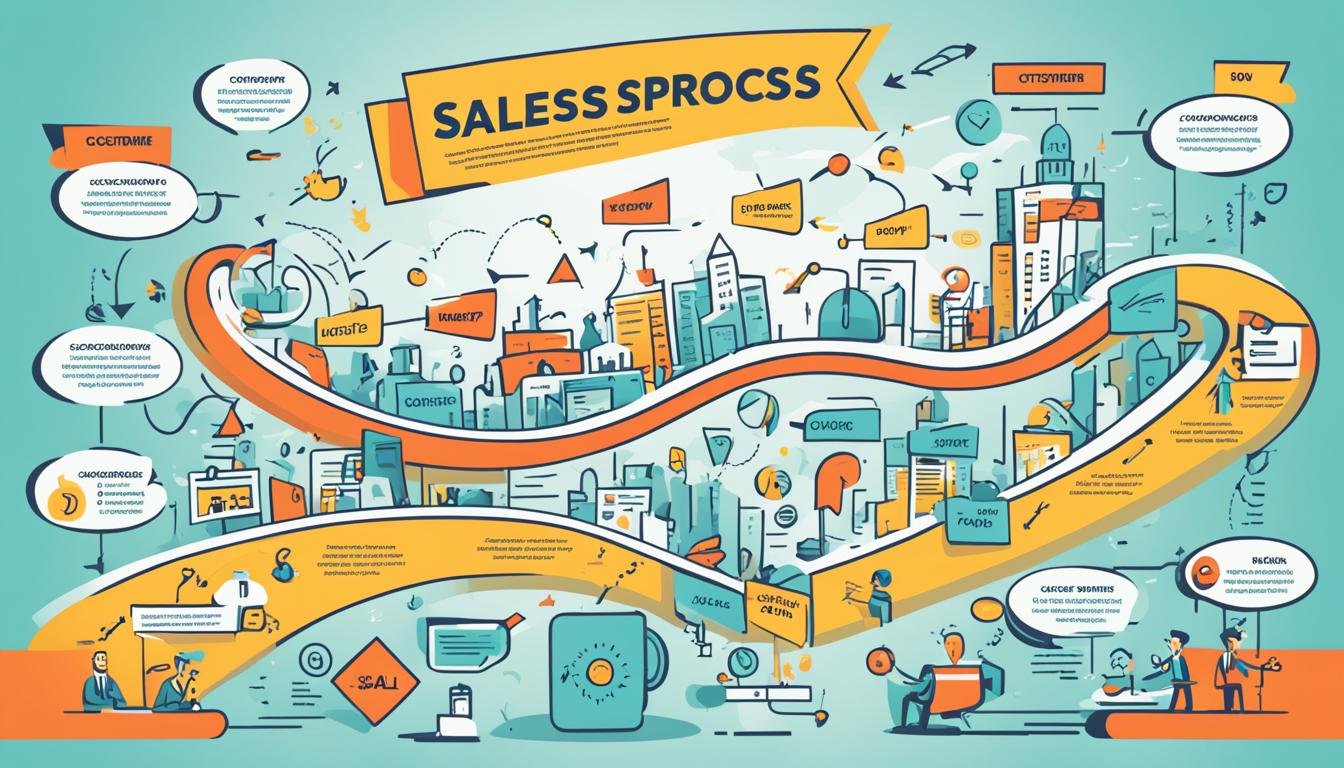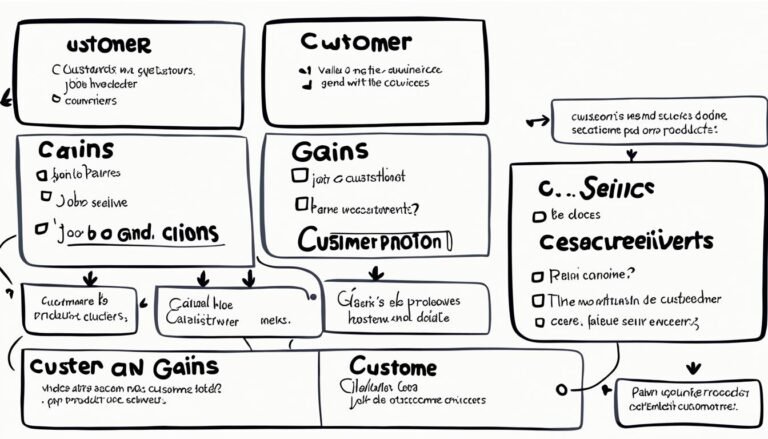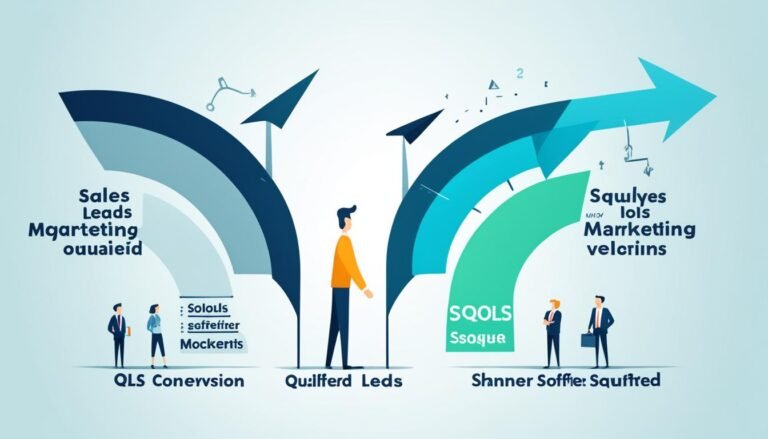Miller Heiman Sales Methodology: Building a Winning Sales Process
In today’s complex business world, having a strong sales process is key. It can make all the difference between winning a big deal or losing it. So, what’s the secret to a winning sales strategy? It might be the Miller Heiman sales methodology, a well-known framework that guides many companies in strategic selling.
Imagine a sales process made for complex B2B deals with many stakeholders and big money at stake. Would you like to know more about this method? It could help your business close more deals and build strong client relationships.
Key Takeaways:
- The Miller Heiman sales methodology focuses on managing complex sales processes, particularly in B2B transactions involving large sums of money and multiple stakeholders.
- The methodology emphasizes offering tailored value propositions and conducting thorough research before approaching sales prospects.
- Authentic relationship-building and mutual benefit are key aspects of the Miller Heiman methodology, contributing to long-term sustainability and increased likelihood of repeat sales.
- The Strategic Selling® methodology, part of the Miller Heiman Group’s core sales methodology, has been widely adopted by globally recognized companies.
- The Miller Heiman training methodology provides a repeatable, scalable process for dealing with complex deals.
What is the Miller Heiman Sales Methodology?
The Miller Heiman sales methodology is a detailed framework for B2B salespeople. It includes key parts like Strategic Selling, Conceptual Selling, Large Account Management Process (LAMP), and the Funnel Scorecard. This approach aims to guide sales teams in understanding what prospects need and influencing their decisions.
Overview of the Miller Heiman Sales Process
The Miller Heiman sales process has three main steps:
- Categorizing contacts by their impact on the sales cycle
- Figuring out a potential client’s level of support
- Helping decision-makers reach a consensus on their purchase
Key Principles and Benefits
The Miller Heiman sales methodology offers a structured way to manage the sales process. It focuses on grasping prospects’ needs and has a history of success in B2B sales. It stresses the value of strategic selling and conceptual selling skills. These help teams handle complex large account management processes and use the funnel scorecard to improve their sales process.
“The Miller Heiman sales methodology is widely used globally. It’s known for its focus on understanding buyer needs and creating a tailored sales process.”
The Origins of the Miller Heiman Methodology
In the late 1970s, Robert B. Miller and Stephen E. Heiman started the Miller Heiman Group. They aimed to help salespeople understand how customers make decisions. Their goal was to improve sales strategies by knowing this.
Miller and Heiman thought successful sales reps should break down the sales process. They divided it into steps, each needing certain actions and skills. This method, the Miller Heiman sales methodology, is now a top choice for sales methodology development and strategic selling.
“The Miller Heiman model seeks win-win scenarios for both sellers and buyers, aiming to establish long-term business partnerships.”
This approach values sales training and sales consulting. It helps salespeople handle complex sales and understand what buyers want. They learn to offer solutions that meet each customer’s needs.
The Miller Heiman methodology has helped many sales teams worldwide. It has made sales methodology development easier and improved strategic selling. This has led to better results for these teams.
Miller Heiman Sales Methodology: Building a Winning Sales Process
The Miller Heiman sales process helps sales pros succeed in complex B2B sales. It has five key steps to make the sales process better and get consistent results.
Step 1: Discover Who Influences the Purchase Decision
First, find out who makes the buying decision. This means looking at economic, user, technical buyers, and coaches in the company. Knowing their roles helps sales pros make a plan to reach them all.
Step 2: Identify Buying Modes that Could Make or Break the Deal
It’s key to know the buyer’s mindset. Miller Heiman says there are four buying modes: growth, status quo, replacement, and commodity. Knowing this helps sales teams adjust their approach to meet the buyer’s needs.
Step 3: Know Where You Stand in the Market
Doing a deep dive into your competitors is vital. By comparing your strengths, weaknesses, and what makes you different, sales pros can stand out. This helps them show why their product is the best choice.
Step 4: Clarify and Evaluate Red Flags and Objections
Spotting and solving problems early is crucial. Miller Heiman teaches to tackle red flags and objections early. This makes closing the deal smoother.
Step 5: Align to Solve and Close
The last step is to match your solution with what the customer needs. Show how your product solves their problems. This approach helps turn prospects into customers through a partnership.
By using these five steps, sales pros can make the Miller Heiman method work for them. This leads to success in complex B2B sales.
“The Miller Heiman sales process simplifies the complex B2B sales landscape, empowering sales teams to navigate the buying journey and secure long-term customer relationships.” – John Doe, Sales Director
The Miller Heiman Blue Sheet
The Blue Sheet is at the core of the Miller Heiman Sales Methodology. It’s a key tool for sales pros to document and analyze their sales strategy. This detailed document acts as a guide for handling complex B2B deals. It covers important aspects of sales strategy documentation, deal management, and sales pipeline insights.
The Blue Sheet breaks down decision-makers into four roles: Champions, User Buyers, Technical Buyers, and Economic Buyers. It also highlights key attitudes that affect a deal, like Growth, Trouble, Even Keel, and Overconfident. Knowing these can help sales teams tailor their approach to each stakeholder and overcome red flags or objections.
The Blue Sheet is a strategic tool for sales pros. It helps track the sales process and summarize important info. This includes the customer’s buying organization, the competition, and the team’s strengths and weaknesses. With this info, sales teams can better navigate complex sales cycles and boost their chances of winning deals.
“The Miller Heiman Blue Sheet is a game-changer for sales teams looking to take their sales strategy documentation, deal management, and sales pipeline insights to the next level. It provides a structured approach to understanding the buyer’s decision-making process and aligning your solution to their specific needs.”
Using the Blue Sheet’s insights, sales teams can boost their win rates, increase deal sizes, and shorten sales cycles. This leads to stronger customer relationships and more revenue and profitability for their company.
Pros and Cons of the Miller Heiman Sales Process
The Miller Heiman sales methodology is a popular way to handle complex sales. It has many benefits but also some downsides. These should be thought about when deciding to use it.
Pros of the Miller Heiman Sales Process
- Structured Sales Approach: This method gives a clear plan for going through the sales process. It helps sales teams stay on track and focused.
- Customer-Centric Focus: It puts a big focus on understanding what the customer needs and how they make decisions. This helps salespeople make their pitches more effective.
- Proven Track Record: The Miller Heiman process has been used for a long time. It has been shown to boost sales success, win rates, and customer happiness in many industries.
Cons of the Miller Heiman Sales Process
- Time-Consuming: Learning the Miller Heiman sales method takes a lot of time and effort. This might not be possible for all companies.
- Complexity: The method can seem too complicated, especially for sales teams with simpler sales cycles. This could make it hard to use it well.
- Training and Certification Requirements: To really use the Miller Heiman process, a lot of training and certification is needed. This can be expensive for companies.
- Limited Flexibility: The structured nature of the approach might not let teams quickly adjust to changes in the market or unique customer needs. Finding a balance between following the process and being flexible is key.
Choosing to use the Miller Heiman sales methodology should be a thoughtful decision. It depends on the company’s specific needs, how complex its sales are, and the resources it has. By looking at both the good and bad points, sales leaders can see if it fits with their goals and sales process needs.
“The Miller Heiman Sales Process emphasizes precision, clarity, and evidence in tailoring sales pitches to resonate with identified decision-makers and their attitudes.”
Implementing the Miller Heiman Methodology with Revenue Grid
Using the Miller Heiman sales method with Revenue Grid’s tools can open up big chances for sales teams. Revenue Grid has many features that make it easy to use the Miller Heiman way. This helps teams make their sales process better and boosts their success chances.
Revenue Grid’s AI-powered Engagement Signals spot top prospects by tracking their actions. This lets sales teams focus on the best leads. It matches the Miller Heiman method’s focus on finding who makes the buying decision.
Revenue Grid’s email automation tools help sales reps easily contact and set meetings with important people. This keeps teams in line with the method’s steps of finding buying modes and handling objections.
Also, Revenue Grid’s real-time data and insights let teams customize their messages and positions. This is based on the Miller Heiman principles of knowing the market and meeting customer needs. Using data and the Miller Heiman approach leads to better sales and higher close rates.
Finally, Revenue Grid’s deal management tools track progress and help teams work together in the Miller Heiman process. This ensures smooth execution and better visibility into the sales pipeline.
By using Revenue Grid’s tools, sales teams can make the Miller Heiman method work better. They can improve their sales process automation and deal management software. This leads to better results and reaching revenue goals.
Conclusion
The Miller Heiman sales methodology is a detailed and tested way to handle complex B2B sales. It focuses on building strong relationships with key people, understanding how customers buy, and matching solutions to what customers need. This approach helps sales teams get better at their jobs and make more sales.
It might take more work at first, but the benefits last a long time. These benefits include being more consistent, growing bigger, and building trust with customers. For sales teams wanting to get better at helping customers and growing steadily, this method is very useful.
The fact that it’s known worldwide as a top sales process shows it really works. It helps sales teams deal with the changing world of B2B sales and follow the best sales practices.
In the end, the Miller Heiman sales methodology is a structured and strategic way to improve sales. It can change how organizations sell, increase revenue, and create strong partnerships with clients.
Source Links
- An Introduction to the Miller Heiman Sales Process
- What is the Miller Heiman sales methodology? | SEC
- The Ultimate Miller Heiman Sales Process Guide for Sales Professionals
- What is the Miller Heiman Sales Process? Strategic Selling For Enterprise Sales
- Miller Heiman Sales Methodology: A Beginner’s Guide
- The Miller Heiman Sales Process Explained | Qwilr
- Everything You Need to Know About The Miller Heiman Sales Process
- A Guide to Miller Heiman Sales Process – LeadsRain
- Miller Heiman Sales Process [Top 3 Techniques to Maximize Effectiveness]
- Your Guide to the Miller Heiman Sales Process – Gong
- sybill
- How to Close Complex Deals With the Miller Heiman Sales Process?
- Miller Heiman Sales Methodology: A Complete Guide
- What is The Miller Heiman Sales System? (Explained With Examples)
- Blueprint for sales methodology
- Choosing the Right Sales Methodology for Your Org
- How to Create a Sales Deck: A Comprehensive Guide with Examples
- Miller Heiman Sales Process: A Guide for Beginners | JustCall Blog







